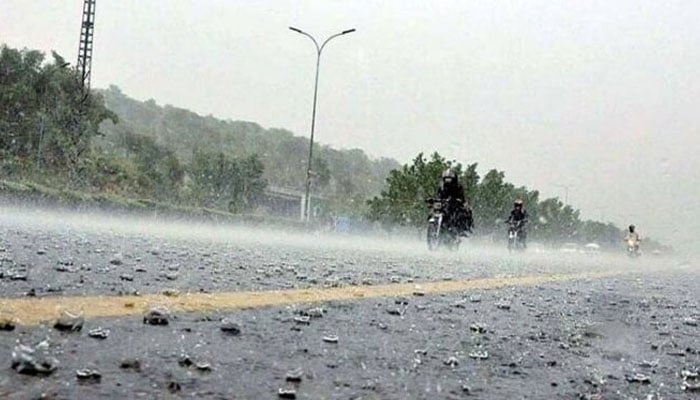Hailstorm, heavy rain likely to hit Rawalpindi, Islamabad today: NDMA
NEOC urges residents to take precautions, secure loose objects, and avoid unnecessary travel during severe weather
April 17, 2025

- Hailstorms could damage vulnerable structures, warns NDMA.
- Severe weather conditions could disrupt agricultural activities.
- Travellers strongly advised to verify road conditions.
Heavy rainfall coupled with strong windstorms, thunderstorms, and isolated hailstorms are expected on Friday and Saturday evenings in various parts of the country, including Rawalpindi and Islamabad, forecast the National Disaster Management Authority’s (NDMA) National Emergencies Operation Center (NEOC) on Thursday.
The forecast came a day after the federal capital and parts of Khyber Pakhtunkhwa (KP) were pummelled by a heavy hailstorm, leaving a trail of destruction that included smashed car windscreens, damaged solar panels, and broken tree branches.
A weather alert advisory for the Pothohar region—including Islamabad and Rawalpindi—as well as upper and central Punjab, warns that from the evening of April 18 to April 19, 2025, severe weather conditions may impact infrastructure, disrupt transportation, and affect agricultural activities.
Strong winds and heavy rainfall may uproot trees, potentially causing temporary power outages. Windstorms, dust storms, and hailstorms could damage vulnerable structures, rooftops, vehicles, and power lines, further warned the advisory.
Additionally, hailstorms pose a threat to crops and outdoor installations, particularly those with glass surfaces. Reduced visibility due to rain and dust may increase the risk of road accidents.
The NEOC urged the residents to take precautions, secure loose objects, and avoid unnecessary travel during severe weather.
The NDMA has urged residents to stay informed by downloading the official Pak NDMA Disaster Alert mobile application for real-time updates.
All citizens, particularly tourists and residents in affected areas, should closely monitor weather developments through official channels only.
Travellers are strongly advised to verify road conditions before departure and postpone non-essential journeys during periods of intense weather activity.
Those residing in or near landslide-prone areas must exercise heightened vigilance and strictly comply with all local safety directives. The public is reminded that timely access to verified information and adherence to official warnings are critical for personal safety and community protection during severe weather events.











